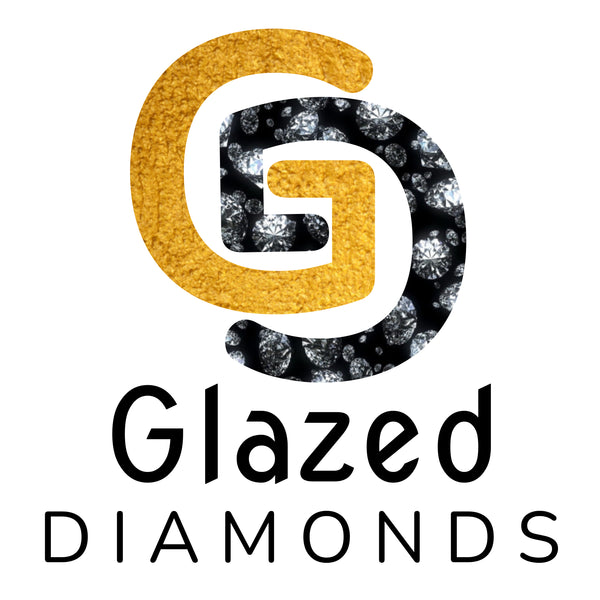What is Moissanite?
Moissanite is like a celestial marvel that has been brought down to Earth. Discovered in the remnants of a meteorite, this gemstone is a captivating blend of stardust and science. Composed of silicon carbide, moissanite dazzles with a sparkle that rivals, and in some cases surpasses, that of a diamond.
Its brilliance is a dance of light and color, casting fiery flashes and a spectrum of rainbow hues that seem almost otherworldly. While it’s nearly as hard as diamonds—scoring a remarkable 9.25 on the Mohs scale—moissanite is known for its ethereal clarity and near-imperceptible flaws. It’s a gemstone forged in laboratories today, ensuring that it’s both ethically sourced and environmentally friendly.
In terms of cost, moissanite offers a luxurious experience at a fraction of the price of diamonds, making it a sought-after choice for those who desire beauty and brilliance without compromise. It’s not just a gemstone; it's a piece of cosmic wonder, beautifully engineered to shine in our world.
What is a Diamond?
The most brilliant masterpieces created by nature are diamonds, which are formed deep within the Earth's mantle under situations of staggering heat and pressure. These dazzling gems are essentially crystallized carbon, where each carbon atom is perfectly bonded in a lattice that transforms ordinary carbon into an extraordinary marvel.
Their unparalleled hardness, scoring a flawless 10 on the Mohs scale, makes them the toughest of all natural materials, able to withstand the test of time and wear with remarkable grace. This durability, combined with their exceptional ability to bend and reflect light, endows diamonds with brilliance and fire that can mesmerize anyone who gazes upon them.
Diamonds come in a symphony of colors, from icy blues to delicate pinks, each hue adding a unique flair to their brilliance. They are symbols of eternal love and unbreakable bonds, often chosen to mark significant life events with their enduring beauty.
What is the difference between Moissanite and Diamonds?

Durability
Diamonds Score an excellent 10 on the Mohs scale of hardness, making them the hardest known natural material. They are highly resistant to scratches and wear, which makes them incredibly durable for everyday use.
Moissanite Score about 9.25 on the Mohs scale. While very durable and hard, moissanite is slightly less scratch-resistant than diamonds. However, it is still very suitable for daily wear and is highly resistant to damage.
Brilliance and Fire
Diamonds are known for their exceptional brilliance due to a refractive index of around 2.42. Diamonds exhibit “fire,” or the dispersion of light into various colors, giving them a classic sparkle.
Moissanite has a higher refractive index (2.65 to 2.69), resulting in even greater brilliance and fire compared to diamonds. Moissanite can display a more intense and colorful play of light, sometimes resulting in a rainbow effect that can be more noticeable than in diamonds.
Color
Diamonds are available in a wide range of colors from completely colorless to various shades, including yellows, browns, and rarer colors like blues, pinks, and greens. The value of diamonds generally increases with their lack of color (colorlessness).
Moissanite typically comes in near-colorless to colorless shades. While generally appearing very clear, some moissanite may exhibit a faint yellow or greenish tint, especially in larger stones. Smaller stones may make this less apparent.
Clarity
Diamonds can have internal inclusions (flaws) and external blemishes. Higher-clarity diamonds with fewer inclusions and blemishes are more useful. Clarity can vary significantly from one diamond to another.
Moissanite generally has fewer visible inclusions and blemishes compared to diamonds. Most moissanite are nearly flawless, and their clarity is usually high, making them appear very clear to the naked eye.
Price
Diamond are typically more expensive due to their rarity, the cost of mining, and the processing involved. Prices are influenced by the Four Cs (cut, color, clarity, and carat weight), and high-quality diamonds can be quite costly.
Moissanite is much more affordable than diamonds. Moissanite offers a similar visual appeal at a fraction of the cost, making it a popular choice for those seeking a beautiful gemstone without the high price.
Sourcing
Natural diamonds can involve significant environmental impact and ethical concerns, such as conflict diamonds. Synthetic diamonds are also available, which are ethically sourced but usually cost more than moissanite.
Moissanite is primarily lab-grown, making it an environmentally friendly and ethical alternative to mined gemstones. The controlled creation process avoids many of the environmental and ethical issues associated with traditional diamond mining.
Moissanite vs Diamond in Engagement Rings

Variety in Shapes and Settings
Moissanite is available in many of the same shapes as diamonds, including round, princess, oval, emerald, cushion, and more. The range might not be as extensive as diamonds, but it covers the most popular shapes. It works well in an expansive variety of settings. Whether you prefer a solitaire, halo, three-stone, or vintage-style setting, moissanite can be used effectively. Jewelers are increasingly skilled at working with moissanite, so you should be able to find or create the setting you desire.
Diamonds are renowned for their wide variety of cuts and shapes. From classic round brilliants to more unique cuts like Asscher or heart-shaped, there’s an extensive selection to choose from. Diamonds also offers a range of custom cuts from specialized jewelers. They are equally versatile in settings, and their extensive history means there’s a vast array of traditional and contemporary styles available. Custom settings are also widely available, allowing for a high degree of personalization.
Durability for Everyday Use
Moissanites fire & brilliance are unparalleled, often outshining even the most bright diamonds with their mesmerizing play of light. Crafted in labs, moissanite offers an ethical allure, free from the traditional concerns of mining. It’s a good-looking choice for those who want a bold, modern statement without sacrificing brilliance or beauty. This Stone's durability means it can handle daily activities well, but like any gemstone, it can benefit from regular cleaning and occasional professional checks to maintain its brilliance.
Diamonds, with their unrivaled hardness and historical prestige, offer a classic allure that has stood the test of time. Each diamond tells a story of ancient origins and rare beauty. Their enduring durability makes them perfect for daily wear, embodying an everlasting commitment with a gleaming promise. Diamonds exude a refined grace that speaks to tradition and luxury, making them a cherished choice for those who value heritage and permanence.
Ethical and Environmental Considerations
Moissanite is predominantly lab-created. This means it is manufactured in controlled environments, minimizing the need for mining and its associated environmental impact. Lab-grown moissanite results from advanced technology and scientific processes, making it a more sustainable and ethical choice. There’s no destruction of habitats, soil erosion, or water pollution linked to its creation. Lab-grown moissanite eliminates concerns about conflict stones and ensures workers are not exposed to harsh conditions or unfair labor practices. The production process is typically more transparent and regulated compared to traditional mining operations.
Diamonds have long been cherished for their brilliance and heritage, but their origins can be a complex tapestry of ethical and environmental issues. Traditional mining has left its mark on the environment, from habitat disruption to water pollution, and has raised concerns about conflict stones. Yet, in this ancient gem lies an evolving story of change and responsibility. The rise of lab-grown diamonds offers a beacon of hope, providing a path to ethical luxury without compromising the splendor and tradition of diamonds. These lab-created diamonds mirror the allure of their mined counterparts while embracing a more sustainable and transparent ethos.
Choosing between moissanite and diamonds invites you to ponder not only the allure of the gem but the impact of your choice. The promise of an ethical and eco-friendly future is evident in the sparkle of Moissanite, created with care for both people and the planet.
Quality and Authenticity Measures
When choosing between moissanite and diamond, imagine them as two distinct stars in the galaxy of gemstones, each with its own story and allure. A diamond is like a celestial jewel that has transcended ages, representing timeless sophistication and permanence. Its brilliance is a refined legacy of nature’s artistry, with each facet capturing and refracting light in a dance of understated elegance. Born from the depths of the Earth, diamonds hold a profound connection to the planet's ancient forces, embodying rare and lasting beauty.
Moissanite is a triumph of contemporary craftsmanship, offering a spectacular brilliance that reflects the ingenuity of modern gemology. With its extraordinary fire and sparkle, moissanite shines with a dynamic energy, capturing light in a dazzling array of vibrant colors. Moissanite embodies a futuristic charm, offering exceptional clarity and brilliance at a more accessible price.
Can moissanite be considered a diamond?
Moissanite cannot be considered a diamond, though they are often compared due to their visual similarities. Carbon atoms are organized in a crystal lattice, making diamonds. This specific arrangement gives diamonds their remarkable hardness and optical properties. Moissanite is composed of silicon carbide. It has a different crystal structure and chemical composition, which results in its own unique set of optical characteristics.
Moissanite has a higher refractive index than diamonds, which often results in even more brilliance and fire. The light performance of moissanite can sometimes appear more intense and colorful compared to diamonds. Moissanite is a unique gemstone in its own right and offers a different set of advantages compared to diamonds.
Why choose moissanite?
Moissanite isn’t just a gemstone; it’s a radiant revolution in the world of fine jewelry, where stellar brilliance meets ethical elegance. Envision a gemstone that captures the essence of celestial brilliance and technological artistry—moissanite is precisely that. It is a shimmering marvel where the cosmic allure of stardust converges with the finesse of cutting-edge creation, delivering an unrivaled radiance that is both mesmerizing and forward-thinking. Choosing moissanite means embracing a dazzling future while honoring the timeless allure of precious stones. With moissanite affordability, you have the opportunity to choose larger sizes and elaborate settings, resulting in a unique and personal expression of beauty.
Why are diamonds preferred over Moissanite?
Diamonds are often preferred over moissanite for several reasons. For centuries, diamonds have been viewed as the ultimate symbol of luxury, commitment, and everlasting love. This deep-rooted tradition often makes diamonds the preferred choice for significant life events, like engagements and anniversaries. Diamonds are known for their long history and cultural significance, often associated with status and timeless elegance.
This traditional symbolism can outweigh the modern allure of moissanite. Their natural formation process and relative rarity imbue them with a unique mystique and intrinsic value that a lab-created gemstone cannot replicate. While moissanite dazzles with its unique brilliance, some people prefer the traditional, time-honored sparkle of a diamond. Diamonds are cherished not just for their physical beauty but for the rich tapestry of tradition, rarity, and prestige they represent. They are the timeless icons of luxury, revered for their natural origins and the profound symbolism they carry through the ages.
With a commitment to ethical practices, Glazed Diamonds offers wedding bands and engagement rings with moissanite or diamonds that are ethically mined. If you want to make an informed choice between these two enchanting gems, check out our engagement ring collection today!




